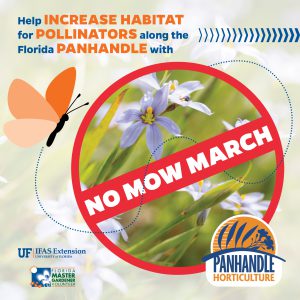
As a boy I remember our St. Augustinegrass lawn. I fondly remember winter annual weeds in that lawn.
Many of these so called “weeds” are native wildflowers and a number of pollinators use these wildflowers.
To see clumps of winter annuals in our yard and in neighbors’ yards was a natural part of the transition from winter to spring. They added interest to the lawn. It was expected to see henbit with its square stiff stems holding up a display of small pinkish purple flowers in late winter to early spring. A clump of henbit was a great place to hide an Easter egg, especially a pink or purple one.
Wild geranium offered another good hiding place for eggs with its pink to purple flowers. Large clumps of annual chickweed would nicely hide whole eggs. Green colored eggs would blend with chickweed’s green leaves.
Crimson clover with its reddish flowers, hop clover and black medic with their bright yellow flowers provided good hiding places for Easter eggs. Plus, clovers add nitrogen back to our soils.
The lawn was healthy and thick enough to limit summer weeds. But during fall and winter, as the lawn would naturally thin and go dormant, these winter annuals would run their course.
I remember the clean smell of freshly mowed grass in spring with the first mowing. Once mowed and as the heat took its toll, by late April or mid-May, these winter annuals were gone. What was left was a green lawn to help cool the landscape as the weather warmed. The lawn was mowed high as St. Augustine should be, watered only occasionally during dry periods, played on and typically not worried with.
winter annuals were gone. What was left was a green lawn to help cool the landscape as the weather warmed. The lawn was mowed high as St. Augustine should be, watered only occasionally during dry periods, played on and typically not worried with.
Most lawns have winter annuals that let us know spring is near. Perhaps we worry too much with these seasonal, temporary plants that may have wrongly been labeled as weeds. Besides, how long have we been doing battle with them and they are still here. Most lawns have winter annual seeds that await the cooler temperatures and shorter days of early winter to begin yet another generation. By May they are gone.
UF/IFAS Extension agents in the Florida Panhandle are asking you to join in on “No Mow March” in 2023. The idea is to holdup on mowing until the calendar flips to April, allowing pollinators to enjoy these common winter annuals.
Here is a website with more information on No Mow March. On this site, you’ll find a link to sign up to be a participant, check out what Okaloosa and other counties are doing by clicking on “Events” and see more about pollinators, all on this site.
https://sfyl.ifas.ufl.edu/escambia/lawn-and-garden/no-mow-march
 0
0
